9.00 – 9.15
Welcome
9.15 – 10.00
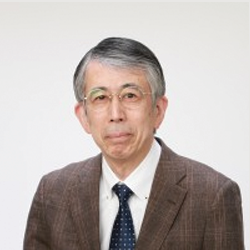
Keynote Speaker
Prof. Seiichi Koshizuka, Univeristy of Tokyo
Spiral development of MPS involving users, vendor and universities
Moving Particle Semi-implicit (MPS) method is one of the particle methods which do not need mesh for computational fluid dynamics. The MPS method is based on weighted differences for discretization of the differential operators, while Smoothed Particle Hydrodynamics (SPH) uses the derivatives of the kernel.
Recently, various computational techniques for the particle methods have been studied, for instance high-order schemes, variable spatial resolution, surface tension, wettability, non-Newtonian fluids and multi-phase flows. The commercial software is simultaneously developing in the cooperative relationship among users, vendor and universities.
Topics: Moving Particle Semi-implicit, Smoothed Particle Hydrodynamics
Seiichi Koshizuka has held a professorship at the University of Tokyo since 2004 and serves as a director at Prometech Group, Inc. In 1996, he authored the pioneering scientific paper on the Moving Particle Semi-implicit (MPS) method, credited with inventing this technique. The MPS method, initially conceptualized by Professor Koshizuka, forms the foundation of Particleworks software, designed specifically for simulating incompressible, viscous, and free surface flows.
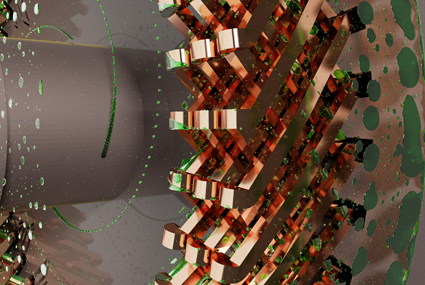
10.00 – 10.30
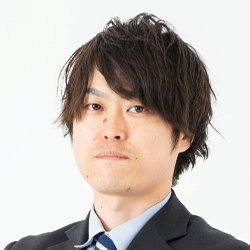
Prometech Software | Shun Fujimoto
An overview of the new features of Pw8.1 and Gw3.1.
As a leading-edge particle method software vendor, Prometech Software has continued to pursue new possibilities in MPS particle methods.
In this presentation, we will introduce the latest versions, Particleworks 8.1 and Granuleworks 3.1, showcasing new features and improvements, along with exhibiting their applicability across various industry fields.
We commit to continuing to tackle challenging problems and driving technological innovation forward.
Topic: Particleworks new version and future developments
After receiving the PhD degree in Fluid Engineering from the Yamagata University in Japan, he joined Prometech Software in 2016.
Since then he has been part of the consulting services team and he has gained extensive experience in various types of CFD analyses across different industries.
Currently, he is Technical Manager of the Consulting Team.
10.30 – 11.00


Particleworks Europe | Michele Merelli and Gianluca Parma
Machine Tools Cooling Simulation
The advancement of new machining tools and the enhancement of current technologies necessitate a comprehensive understanding of high-speed coolant flow and its interaction with the rotating tool.
Moving Particle Simulation has demonstrated itself as a rapid and accurate technique for simulating coolant flow, evaluating its cooling efficiency, and determining tool temperature. This presentation showcases the simulation method based on meshless-CFD and conjugate Heat Transfer, offering practical examples and references to the enhanced capabilities of Particleworks 8.1.
Topics: Heat Transfer, Particleworks new version
Michele joined EnginSoft in 2019, after an internship in ABB. He achieved his Master Degree in The Netherlands (Rijksuniversiteit, Groningen), after a Bachelor in Materials and Nanotechnology Engineering in Italy (Politecnico di Milano, Milan). He focused on simulations with Moving Particle Simulation ever since joining EnginSoft, specializing in e-motor cooling and thermal management simulations, supporting several companies with remote assistance and onsite visits across Europe. Currently, he is Project Engineer in EnginSoft and Pre- and Post- Sale Manager for the Moving Particle Simulation software Particleworks in Europe.
After the Master Degree in Aeronautical Engineering, Gianluca Parma spent two years as research assistant at Politecnico di Milano studying numerical methods for ice-accretion prediction on flying vehicles. From 2018 he joined EnginSoft where he focused on simulations based on the meshless Moving Particle Simulation method, specializing in engine lubrication and cooling applications. Currently, he is Project Engineer at EnginSoft and Technical Manager for the Moving Particle Simulation software Particleworks in Europe.
11.00 – 11.45
COFFEE BREAK
11.45 – 12.15

MAN Energy Solutions SE | Sebastian Spengler
Investigation on oil and air interactions at sealing areas of a turbomachinery using MPS+FVM two-way coupled simulation approaches
Turbomachinery often uses plain bearings for the axial and radial bearings with oil as lubricant. This type of bearing provide a robust and cost efficient solution. Already current applications require tight sealing systems protecting the flow area of the turbomachinery from the oiled area around the bearings. In this study a two-way coupled approach of MPS and FVM is used to simulate the strong interaction between oil and air in the sealing area that protects the compressor side of a turbocharger from oil. As these simulation are beyond the state of the art a verification approach with a demonstrator was investigated showing good agreement with the simulation. Beside the positive results the challenges with regard to hardware an modelling are also part of the study.
Topics: turbomachinery, LUBRICATION, TEMPERATURE
OTHER AUTHORS: Stefan Rost, MAN Energy Solutions SE, Germany | Gianluca Parma, EnginSoft, Italy | Riccardo Sala, EnginSoft, Italy
2007-2012 | Diploma in mechanical engineering at the Technical University of Munich.
2013-2018 | MAN Energy Solutions SE: - Turbocharger development - Expert Structural Mechanics, focus on fluid-structure-interactions and HCF - Responsible for the component development of radial compressors
2018 - 2023 | MAN Energy Solutions SE: - General project manager for developing a high pressure turbocharger and two-stage turbocharging
2021 - today | MAN Energy Solutions SE: - Head of Turbocharger Mechanics and Rotordynamics Group
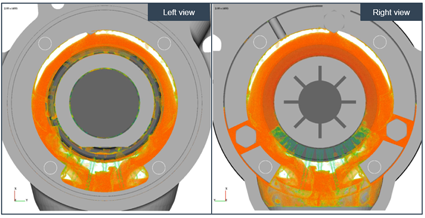
12.15 – 12.45

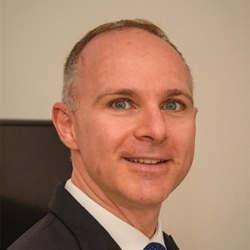
SKF Industrie | Mehul Pandya and Fabrizio Mandrile
Predicting lubricant behaviour and temperatures in ball bearings
Lubrication in bearing is crucial to ensure smooth operation, to minimise friction and wear, to prevent corrosion and to dissipate heat generated during operation thereby extending bearing life. CFD (Computational Fluid Dynamics) ensures effective lubrication in bearing by providing valuable insights that physical tests alone cannot achieve. However, CFD simulations are time consuming, often it takes weeks to achieve an accurate representation of the fluid churning in a rotating bearing. Computational time even increases when solving the heat flow combined with the fluid flow.
Particle-based meshless fluid dynamics simulation software operates without mesh generation, significantly reducing the time spent on preprocessing the simulation model. It also excels in precisely capturing the free surface flows, handles complex boundary conditions and so it is suitable for moving parts like bearings. This article presents methods to improve the prediction and understanding of the lubricant behaviour and the heat transfer for an identified, common ball bearing. It addresses this matter by using two approaches (1) Analysing the oil behaviour using particle-based method and coupling it with FE for performing steady state thermal analysis-Segregated approach. (2) Performing conjugate heat transfer (CHT) analysis directly within the particle-based simulation sw to directly compute the bearing temperatures-Coupled approach.
The objective of this comparison is to assess the simulation time, accuracy and to determine best practice for thermal simulations. In the segregated approach, the oil churning is first calculated, then used to map the heat transfer coefficients at the fluid-solid interfaces. These mapped heat transfer coefficients are taken as input for a FE model which calculates the bearing temperatures. However, the particle-based simulation sw also has an inbuilt solver coupling convection and conduction, which is used to directly calculate the bearing temperatures by solving the conjugate heat transfer analysis using coupled approach. Both these methods are relevant in an application conceptual stage where rapid design changes are required. Further comparison is provided against a traditional CFD method and physical tests. It is observed that, one way approach is faster and closer to test results for the approximations taken. Coupled approach (CHT) is more reliable when there is a requirement to get temperature distribution in oil with varying loads.
Topics: BEARINGS, LUBRICATION, THERMAL ANALYSIS
12.45 – 14.00
LUNCH
14.00 – 14.30


EnginSoft, Riccardo Sala | FunctionBay, Uwe Eiselt
Soft closure systems: Fluid Structure Interaction by Moving Particle Simulation and Full-Flex Multi-body analysis
Soft closure systems are found in our houses and offices and make our pieces of furniture more comfortable, silent and long-lasting. Closure dampening is based on deformable pistons moving in a closed housing filled with a viscous liquid. The motion of the piston in a fluid dissipates part of the kinetic energy during the closure process. The dampening is the result of different phenomena, related to the deformability of the piston, fluid pressure and viscous dissipations due to the fluid flow in narrow gaps. Simulating the fluid flow and calculating the forces acting on the undeformed piston is a simple task for any good CFD software, but considering the deformation of the piston under the fluid action, and simulating the complete closure of gaps is way more complicated. The complete simulation of these phenomena requires coupling and co-simulation of a CFD and an FEA tool, with a 2-way fluid-structure-interaction. The CFD software must be able to handle complete closure of gaps and contacts between bodies initially separated. The FEA model has to include the non-linear behavior of the materials and large deformations under the fluid forces. Moreover the simulation process must be easy to set-up and numerically stable, so that it can be used for industrial applications. This presentation explains how these modelling challenges have been tackled and solved with the Moving Particle Simulation software Particleworks coupled to the full-flex multi-body solver RecurDyn. The results of the co-simulation are presented and compared with experimental data.
Topic: Fluid-Structure Interaction
Riccardo Sala is an application engineer at EngiSoft and an expert of Particleworks. He holds a master degree in mechanical engineering from the Brescia university (Brescia, Italy, 2020) and a research master in fluid mechanics from the Von Karman Institute of Fluid Dynamics (Brussels, Belgium, 2021). His works include high viscous fluids, transmission lubrication, and e-motor cooling.
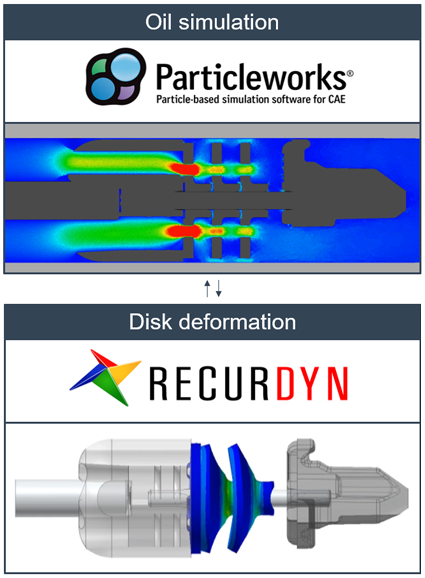
14.30 – 15.00

Handtmann | Marcel Nusser
Study of flow and distribution of particles in meat emulsions in high performance sausage production processes
The present study aims to demonstrate the potential of utilizing advanced flow simulations in the context of industrial production of hot dog sausages. Specifically, the focus is on simulating meat emulsions containing particles, which requires a comprehensive understanding of the underlying process, material properties, and fundamental physics principles. The objective is to investigate whether the coupling of Discrete Element Method (DEM) and Moving Particle Simulation (MPS) methods can accurately predict the behavior of complex flows within meat processing machinery. Such predictions are of great interest for optimizing the geometry of machine components, thereby enhancing efficiency and improving the desired product characteristics. Leveraging the expertise provided by EnginSoft support, a thorough investigation and understanding of these phenomena have been achieved. The simulation results, including the particle distribution in meat emulsions, are presented and compared against experimental data obtained from actual sausages.
Topic: FOOD AND BEVERAGE PRODUCTION
Marcel Nusser has been part of several innovative product development projects as engineer and project manager such as automation and digitalization projects at Handtmann. Together with his team of engineers of different disciplines he acts as idea multiplicator and innovation driver within the filling and portioning division, towards customers and within the market. He is concerned with evolutional and disruptive innovation, digitalization, digital twins, automatization, usability, functional-related and scientific issues in all machinery systems of Handtmann. He deals intensively with current trends and developments in the markets and drives projects in the field of Drives, Sensors, Simulation, IoT and AI.
15.00 – 15.30
Valeo | Fabien Malcoiffe
Reducer Lubrication: Correlation activities for further development
Simulation has been developed for decades to reduce leadtime, development cost and to push further the products optimization. Recently, Particles-based methods have emerged in CFD domain, unlocking a new trade-off between results accuracy and leadtime. VALEO has investigated this new type of Simulation with ParticleWorks to develop its products and furthermore its eDrive reducers. During 2024 VALEO has methodically developed its reducer models with the strong and proactive EnginSoft support to reach a very promising correlation level, unlocking further virtual optimization. Throughout this paper VALEO will expose its approach, the overcome hurdles and the final promising situation for the future.
Topics: Gaerbox Lubrication, Validation
Aerodynamic and Power Unit Performance Engineer
18 years in Formula One, from Intern to Head of Performance Development Group at Renault Sport F1 over 12 years, and 6 years at McLaren and Ferrari as Track AeroPerformance Engineer, I have joined Valeo in March 2023.
15.30 – 16.00
COFFEE BREAK
16.00 – 16.30

HES-SO Valais/Wallis | Jean Decaix
Simulation of a Pelton turbine performance
The simulation of the ow in a Pelton turbine is a challenging task for mesh based methods due to the air/water mixture and the rotation of the runner. Meshless based methods are better suited for such flows and take advantage of the GPU architecture to speed up the calculation. Simulations of a Pelton turbine are carried out using the software Particleworks based on the Moving Particle Simulation, which is a meshless method. The efficiency drop due to the "falaise" effect and the erosion of the splitter are computed and compared with either experimental measurements or the literature. The results show that this method is able to capture the tendency of the efficiency drop in agreement with the available data and at a lower computational cost than the mesh based methods. These encouraging results should motivate the community to test and validate such an approach.
Topic: PELTON TURBINE
Jean Decaix is today a senior scientist at HES-SO Valais/Wallis in the hydroelectricity research group. He holds a master degree from ENSE3 (Grenoble, France) in 2009 and a PhD degree in fluid mechanics from the Grenoble Alps University in 2012. The topic of the PhD was the simulation and modelling of a turbulent/cavitating flow. Its main topics of research are:
- The simulation by CFD of the flows through hydraulic turbines and pipes of hydropower plat.
- The simulation of cavitating flows and the study of the interaction between turbulence and cavitation.
- The simulation of fluid/structure interaction related to hydraulic machines.
- The simulation of free surface or pressurized water networks by 1D models.
- The simulations of various flows as for instance extrusion of high moisture extrusion cooking processes, flow around buildings.
The tools used to carry out these simulations are mainly:Ansys (CFX, Fluent, Mechanical.), OpenFOAM, Particleworks, Epanet, RS Minerve.
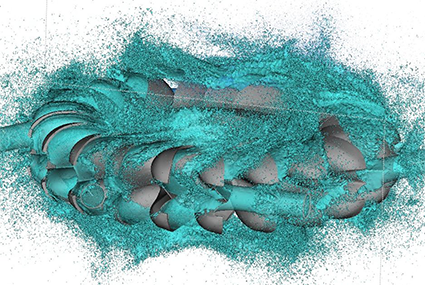
16.30 – 17.00

Punch Powertrain | Alberto Arcos
Particleworks in the Product Creation Process of EV drive units
The introduction of Moving Particle Simulation (MPS) in the Product Creation Process (PCP) of new generation Electrical Drive Units (EDU) at Punch Powertrain has demonstrated the potential of Particleworks on the way to Virtual Prototyping. This presentation is meant to give insight into this journey
Topic: ELECTRIC VEHICLE POWERTRAIN
Punch Powertrain Germany
Lead Engineer Fluid and Thermal Systems: Six years of experience in the R&D of EV drive units
German Aerospace Center
Research Fellow: Two years of experience in the research of CFD methods
Technical University of Braunschweig
M.Sc. Computational Mechanical Engineering
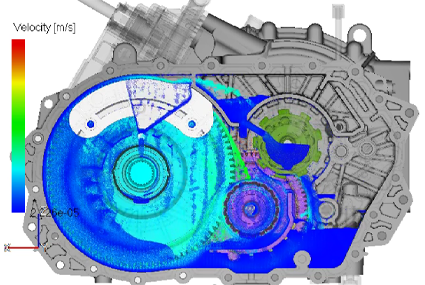
17.00 – 17.30
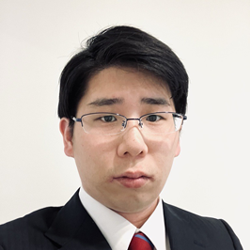
Prometech Software | Satoshi Takeshige
Joining Techniques for Lightweight Structures: Friction Stir Welding and FRICTION Stir Spot Welding with Particleworks
In the automotive and aerospace industries, reducing structural weight while maintaining strength is critical. One effective approach is using multi-material structures with non-ferrous materials such as aluminum and fiber-reinforced plastics. This requires technologies that can efficiently join dissimilar materials with minimal heat input. This presentation highlights friction stir welding (FSW) and friction stir spot welding (FSSW) as key joining techniques. It will showcase analysis and simulation methods using Particleworks, featuring specific customer case studies to illustrate the practical applications and effectiveness of these technologies.
Topics: Lightweight multi-material structures, Friction Stir Welding
Satoshi Takeshige, Ph.D.
2016-2019
Ph.D (Science/Astronomy), Kyoto University
Research Focus: Numerical simulations of neutron stars using relativistic-radiative magnetohydrodynamics
2019-2022
Fluid Analysis Engineer, Software Cradle
Responsibilities: Thermal fluid analysis of rotating machinery, free surface analysis using
the VOF method, fluid-structure interaction analysis
2022-present
Assistant Manager, Customer Success Team, West Japan Branch, Engineering Business Division, Prometech Software
17.30 – 17.40